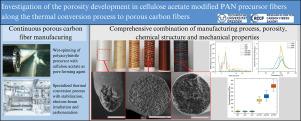Investigation of the porosity development in cellulose acetate modified PAN precursor fibers along the thermal conversion process to porous carbon fibers
IF 3.9
Q2 MATERIALS SCIENCE, MULTIDISCIPLINARY
引用次数: 0
Abstract
Porous carbon fibers offer significant potential as multifunctional materials for super-capacitors and structural batteries due to their low density, high electrical conductivity, mechanical strength, and large specific surface area. This study investigates the development of porous carbon fibers derived from polyacrylonitrile precursor fibers modified with cellulose acetate, used as a pore-forming additive. The fibers were produced via a continuous wet-spinning process, followed by electron beam irradiation, thermal stabilization, and carbonization at three different temperatures: 700 °C, 800 °C, and 900 °C. The influence of these processing steps on porosity and mechanical performance was systematically analyzed. Morphological and structural characterization using scanning electron microscopy and nitrogen physisorption (Brunauer–Emmett–Teller method) revealed a transition from meso- and macro-porous architectures to dominant micro-porosity at the fibers surface. The highest specific surface area of 165.51 /g was obtained for the fiber carbonized at 700 °C, with pore sizes ranging from below 2 nm to above 80 nm. As the carbonization temperature increased, surface area decreased while mesoporosity became more pronounced. Raman spectroscopy was employed to evaluate the degree of carbon ordering. Mechanical testing demonstrated an inverse relationship between porosity and strength: tenacity increased from 2.85 cN/tex at 700 °C to 4.76 cN/tex at 900 °C, while elongation at break decreased. These findings highlight the critical trade-off between surface area-driven electrochemical functionality and the preservation of mechanical integrity. The results provide valuable insights into the optimization of porous carbon fibers for multifunctional applications in energy storage and structural systems.

醋酸纤维素改性PAN前驱体纤维在热转化成多孔碳纤维过程中孔隙度发展的研究
多孔碳纤维由于其低密度、高导电性、机械强度和大比表面积等优点,在超级电容器和结构电池中具有巨大的潜力。本研究以聚丙烯腈前体纤维为原料,经醋酸纤维素改性制备多孔碳纤维。纤维是通过连续湿纺丝工艺,然后在700°C、800°C和900°C三种不同的温度下进行电子束辐照、热稳定和碳化来生产的。系统分析了这些工艺步骤对孔隙率和力学性能的影响。利用扫描电子显微镜和氮物理吸附(brunauer - emmet - teller方法)进行的形态和结构表征揭示了纤维表面从中孔和大孔结构到主要微孔结构的转变。700℃碳化纤维的比表面积最高,为165.51 m2/g,孔径范围从2 nm以下到80 nm以上。随着炭化温度的升高,比表面积减小,介孔现象更加明显。采用拉曼光谱法评价碳有序度。力学测试表明,孔隙率与强度呈反比关系:韧性从700℃时的2.85 cN/tex增加到900℃时的4.76 cN/tex,而断裂伸长率则下降。这些发现强调了表面积驱动的电化学功能和保持机械完整性之间的关键权衡。该结果为多孔碳纤维在储能和结构系统中的多功能应用的优化提供了有价值的见解。
本文章由计算机程序翻译,如有差异,请以英文原文为准。
求助全文
约1分钟内获得全文
求助全文
来源期刊

Carbon Trends
Materials Science-Materials Science (miscellaneous)
CiteScore
4.60
自引率
0.00%
发文量
88
审稿时长
77 days
 求助内容:
求助内容: 应助结果提醒方式:
应助结果提醒方式:


